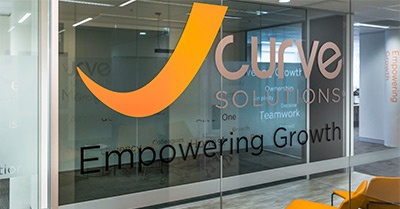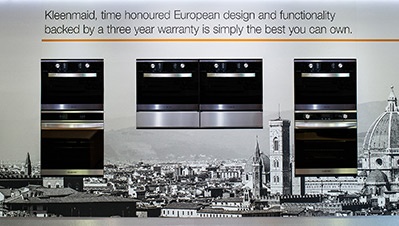Kleenmaid is an Australian success story and a well-known brand supplying high quality European manufactured kitchen appliances. With online and retail sales channels catering for B2C and B2B customers, Kleenmaid turned to technology to provide the real-time visibility, control and mobility they needed.
Find out how Kleenmaid used technology to improve processes and keep head-count down while seeing continued business growth.
Kleenmaid’s Ray Dwyer (National Operations, Logistic & Service Manager), delivered some great insights into:
- Kleenmaid’s business story
- What Ray was looking for in an ERP solution
- Lessons learnt during the implementation phase
- The benefits Kleenmaid has seen since implementing ERP software
- The advantages of mobility, being in control on holidays, and lots more!
Watch the webinar recording or read the transcript below.
Webinar Transcript
Kate Massey:
Thank you again to everyone who has joined us online today for our webinar with JCurve Solutions and one of our fantastic clients, Kleenmaid Kitchen Appliances. We are going to have our webinar today and hear about how Kleenmaid used technology to really turn around their business their growth as well.
I’m Kate Massey, CMO for JCurve Solutions and we’ve got Ray from Kleenmaid. Ray is the National Operations, Logistics, and Service Manager. So it covers a lot of the Kleenmaid business.
Ray Dwyer:
It does. It does. Keeps me busy.
Kate Massey:


We are also an MYOB Advanced Partner, so that’s there cloud ERP offering as well. And what those three platforms have allowed us to do is accumulate hundreds and hundreds of hours of best practice so that we can provide a rapid implementation methodology to help clients go live quicker with ERP when they do make that decision to transform their business and minimise business disruption, which is obviously key for our SME clients.
Over the years we have built one of the largest, most experienced and certified teams of cloud ERP experts as well. So we’ve got a really fantastic team over here at JCurve Solutions, that work with clients to implement their technology solutions.
As I mentioned, over 550 successful ERP implementations. Here’s a snapshot of our clients, Kleenmaid being one of them, Emma & Tom’s, another one of our fantastic clients. We’ve got lots of clients that are inventory carrying, but we do work across a range of industries as well.
Moving on to our agenda for today and what we’re going to hear. Ray is going to talk to us more about the Kleenmaid story, then share with us how they went about finding the right ERP solution that met their specific business needs, talk to us about the implementation process, what they went through to get started with ERP, share with us some of the benefits that Kleenmaid have seen since implementing JCurve ERP, as well as looking at other factors that have helped transform the Kleenmaid business as well. And then Ray is going to share with us another Kleenmaid plans for continued growth.
So Ray, tell us a bit more about the Kleenmaid story.
“2012 we launched again, mainly to kitchen manufacturers. The idea was take the European design and you go to a kitchen manufacturer, you get them to build your kitchen and they would supply the appliances, the handles, the knobs, runners, everything you can want. And that’s where we started. That’s the initial Kleenmaid story.”
Ray Dwyer:


The way that came about is a very interesting story. Our CEO, Danny Hamilton, he just sold his chemical business. He was retired. He was mowing the lawn twice day and washing his car three times a day.
He was getting bored, and he was listening to Ray Hadley on 2GB and as Ray Hadley does, he was getting stuck right into the Kleenmaid management for the liquidation, lost money from people. One of the things Danny picked up was every customer that rang in was saying how great the Kleenmaid product was. How they’ve had it forever, their parents had had it, and they loved it. He then thought, “There’s a business here.” Because he had also lost all his warranty because he had Kleenmaid product as well.
So he thought, “There’s a business here. You can’t let such a good product go.” So he contacted one of his friends who also was in business and they formed a private equity company and then acquired the Kleenmaid name, so we’ve come back with nothing to do with the previous Kleenmaid company. We own the name, so in 2011 we came on board. We set everything up. We met, went around, manufactured their own product, still aiming at the original Kleenmaid philosophy of what’s best. So, it is the best you can own. That’s what we strive to keep all the way through. We look to all the new technologies to bring them into our product.
2012 we launched again, mainly to kitchen manufacturers. The idea was take the European design and you go to a kitchen manufacturer, you get them to build your kitchen and they would supply the appliances, the handles, the knobs, runners, everything you can want. And that’s where we started. That’s the initial Kleenmaid story.
Kate Massey:
At that point, it must have been a big decision that you made not to rebrand, taking on Kleenmaid. They had been in the media quite a lot at the time. How was that process?
Ray Dwyer:
It was a tough situation. There was a number of people that had lost money. We, as our company, we assisted a lot of those people to recover their money.
Ray Dwyer:
We’ve looked after a lot of those people. Not everyone. We couldn’t help everyone, but we looked after a lot of people. And the thing is that people wanted the Kleenmaid product. That’s what they wanted. The brand was slightly damaged. Since then, we’ve been able to rebuild the brand, get the name out there again, and it’s proven to be very successful.
Kate Massey:
Tell us a little more about the process you went through in finding the right ERP solution for Kleenmaid.
“We’re an online B2B business, so everything comes through our website. It automatically feeds into our JCurve ERP system and we then work that from there. So everything is basic.”
Ray Dwyer:
In 2011, I was brought online to help set up the new company. There was a group of three of us that actually started it all up again. Originally the plan was to do what everyone else was doing at the time and have a heap of computers, a network system, server towers and spend a lot of money. Myself and the CFO, we were commonly using Dropbox, which naturally is one of the biggest cloud applications going around. And we then thought, could we do this in business. So we went looking. We actually found MYOB and-
Kate Massey:
And they offered you their products.
Ray Dwyer:
Yes, we actually were ready to sign on the dotted line with MYOB when we heard about the NetSuite product. We thought, well, let’s take a look. We met with the JCurve Solutions team, somewhere around here I think, I don’t remember if this is the same office or not. And we had a meeting and because we knew what we wanted, we were able to throw all the questions at them, and we had a team of people in there that could answer our questions. And the thing that impressed us the most – they kept saying yes. Even when things got a bit tougher, they’d get together and have a little bit of a chin-wag between themselves, and come back and say, “Yes, we can do that.”
That then convinced us because it gave us more flexibility than what the MYOB base did. So that’s when we decided to come on board with JCurve Solutions and use the NetSuite product.
Kate Massey:
You make a good point there, Ray, about knowing what you wanted going into that meeting.
Ray Dwyer:
That’s right. And that’s one of the things, and I know there are a lot of people listening here today, it’s probably one of the most important things when you take this type of system on, is management alone shouldn’t do it. Just forget it, don’t do it. If you haven’t had a sit-down meeting with the grassroots people that are going to use it and found out what is going to make your business operate better, you can make mistakes.
Ray Dwyer:


And we started from the basic. How did we want our sales orders to look? That’s about as basic as you can get. How did we want to process the sale? And we went back to basic retail. We’re an online B2B business, so everything comes through our website. It automatically feeds into our JCurve ERP system and we then work that from there. So everything is basic. And that is one of the biggest things that I’ve learned from implementing systems in other companies; is talk to the grassroots. Because they’re the ones that are going to operate it. They’re the ones that are going to make your business productive. If you give them something that is what most people sitting in the offices want, it may not work.
Ray Dwyer:
I think that’s the main thing that I can say to everyone.
“JCurve ERP is brilliant. I just love it. Last night is a great example. I had a phone call from Europe last night, saying we’ve got a bit of a problem, so I needed to jump on and make some calculations and send off a new purchase order. I was out, I was at my son’s place and I was able to just jump on my iPad, do what I had to do and send it off in thirty minutes, just like that.”
Kate Massey:
So, what are some of the things that you were looking for when you went through the evaluation of an ERP.
Ray Dwyer:
Well we wanted something that was real-time because if we’re going to mend our brand and give our customers higher expectations, we needed it to be real-time. And we needed to be able to process orders quickly and manage our inventory quickly. So we needed full control of the inventory both coming out of Europe as well as what was in our warehouses. We also needed control. We actually give sample appliances to our kitchen manufacturers to display so they’ve got something to sell and we had to really keep control of that as well.
So we needed that inventory management system, which JCurve ERP has been able to give us. For customer records, we basically work on the sales order process and invoice process. So we needed that to be fluid, so we had a process where the sales order would come in, when it was paid, it became an invoice. We needed that so, it needed to fit with the taxation laws, which it did, and we were able to get it to suit all that. So everything had to be fluid.
Then, we had to have ease of management.


JCurve ERP is brilliant. I just love it. Last night is a great example. I had a phone call from Europe last night, saying we’ve got a bit of a problem, so I needed to jump on and make some calculations and send off a new purchase order. I was out, I was at my son’s place and I was able to just jump on my iPad, do what I had to do and send it off in thirty minutes, just like that. I’m a bit of a control freak. I stress out badly. If something’s not right, I won’t sleep. It’s just my nature, so mobility is probably the most important thing to me.
Kate Massey:
I know that you travel between Sydney and Melbourne and some of the other states quite a bit.
Ray Dwyer:
Yes, I do a bit of travel and that’s the good thing about it. I do not have to be in my office to do my job anymore. I’ve now got processes in place, Even when I catch a plane for example, because I travel so much, I always make a point of getting to the airport early enough so I can sit down, jump online and do whatever I have to do. Then, when I jump on the plane, I know everything’s right. I can travel and enjoy my flight. When I get to the other end, same thing, I can jump online, finish up and do whatever I have to do. Because it’s my mobile anywhere. I was just in Europe traveling on holidays. I didn’t do a lot of work, but a couple things popped up while I was in Scotland and I was able to jump online, fix those couple of things, contact my assistant back and say, “You’re right to go now.” And so that mobility, for me personally, gives me sleep because I stress out so badly when things aren’t in order.
“Someone out there that’s listening to us now, could place an order on our B2B site. The moment, milliseconds after they hit submit, it’s on my dashboard or my assistant’s dashboard. We can look at it, if we needed to. We can process it and I can have it delivered tomorrow morning.”
Kate Massey:
Can you talk to us a little bit more about the implementation phase that you went through? You touched on this a little bit already earlier. In fact, you knew what you wanted, you talked to some of your people internally to make sure that what you were actually asking for was going to fit your business.
Ray Dwyer:
I was lucky in the implementation phase, because I’ve already done Point of Sale and inventory management implementations, so I knew what the mistakes were. The biggest mistake is not knowing what you want. So the first thing we did, we knew we had fifty hours worth of training that purchased, and so I sat down with the CFO and I said, “Well by the time we use those fifty hours, we’ll be fully operational, so-
Kate Massey:
So it was training and setup?
Ray Dwyer:


I’ll learn from what you’re showing me, but we’re setting up at the same time. So, we used 42 hours of the training, the next day we pushed the button and went fully operational.
And that was the best way. The good thing about it, we knew how to use it because we’d been involved in the creation. We’d learned all the tricks of the trade, because the implementation person we had was brilliant, absolutely brilliant.
Kate Massey:
That’s good to hear, we have some very good implementation consultants.
Ray Dwyer:
And so by us knowing what we wanted, knowing how we wanted it (we even had drawings about how we wanted the layout of invoices, the sales orders, and the inventory reports), we had all that, along with the KPIs we wanted to set. It was all already in place, so we just used that 50 hours as setup and learning. So, my tip is to have the people that are going to be using the system be part of the setup. So that they’re sitting while your implementation consultant is designing it, working it, and showing them how to set up their dashboards. If the user who’s going to be sitting in front of that dashboard says, “Is there any chance of getting a color code?” Well, yes there is. “Is there any chance of putting a flag or something like that on it?” Yes, there is. And that interaction is a great benefit.
“I was just in Europe traveling on holidays. I didn’t do a lot of work, but a couple things popped up while I was in Scotland and I was able to jump online, fix those couple of things, contact my assistant back and say, “You’re right to go now.” And so that mobility, for me personally, gives me sleep because I stress out so badly when things aren’t in order.”
And I don’t know whether we can see it here, but I have my dashboard sitting here. As you can see by our dashboard, the red means that’s the work I’ve got to do when I leave here. And everything is colour coded all the way down. There’s flags on it. But that’s telling me what we have to do in a timeline.
There are flags on there that tell us what states we’re working with, what warehouse we’re working with, and the intelligence of the unit we’ve been able to put into JCurve ERP… To the point that as far as inventory goes, I don’t have to work out where it’s coming from. We’ve got warehouses in most capital cities and we’ve got next week programmed, so that the system knows where that customer is by post code and it automatically selects the stock out of the right warehouse. And in some situations, such as when you have Tweed Heads in New South Wales. We can program the system to tell it we want that post code to come out of the Brisbane warehouse.
Kate Massey:
It sounds like you’ve really used the technology to drive some real business efficiency. That leads into the benefits, which we already started to touch on, so productivity gains has been a big one. And you’ve really managed to create some really streamlined business processes across the business.
Ray Dwyer:
We have, yes. That’s the good thing about it. I think one of the things we can get an understanding of is that someone out there that’s listening to us now, could place an order on our B2B site. The moment, milliseconds after they hit submit, it’s on my dashboard or my assistant’s dashboard. We can look at it, if we needed to. We can process it and I can have it delivered tomorrow morning.
Ray Dwyer:
We have timelines naturally, but we set a deadline of 3:00 P.M. If it’s in our system by 3:00 P.M. we can deliver it tomorrow, anywhere in Australia. That’s what our customers are expecting these days.
Kate Massey:
You managed to do some really cool things from a customer experience perspective. When orders have been placed, you send automatic notifications from the system.
Ray Dwyer:


Kate Massey:
And that’s all automated.
Ray Dwyer:
All automated, yes. Just automatically happens. When the submit button is hit, that’s when it sends out that one. And we have another one for payments, when your payments are due. It sends out another one, “Just to let you know, reminding you.” When we release it for delivery it sends out another one saying, “Hey, it’s going to be delivered on this day. Just reminding you.” So that they have the opportunity then to come back to us and say, “Well, hold on. I’m not going to be here on that day. Can we change it?” No problem, as long as you tell us. So we try to make the experience of buying Kleenmaid and getting it delivered easy and really clear. With JCurve ERP, we’ve been able to utilise that. And all that sort of stuff came from experimenting. Because we’ve learned so much during the implementation phase, you can go back on that and say, “Okay, you showed me this. Can I do this instead?”
“We’ve got warehouses in most capital cities and we’ve got next week programmed, so that the system knows where that customer is by post code and it automatically selects the stock out of the right warehouse.”
Kate Massey:
And you touched on your dashboards and how that has allowed you to really govern your day, but you also use the reporting side of things?
Ray Dwyer:
Yes, we had a lot of reports. We have, like all businesses, your many reports. We have our KPI’s and before we started here today I checked our KPIs, and they’re looking very good for February.
Ray Dwyer:


Kate Massey:
I know you have exciting plans for the future as well. Can you tell us about the plans for Kleenmaid?
Ray Dwyer:
Well at the moment, we’re working a lot more with the commercial builders at the moment. That’s a big area for Kleenmaid to move into. The original Kleenmaid used to supply a lot of builders with appliances, and we’re finding that a lot of people are coming and asking us if they buy it for that too. We’ve had to change a little bit of our business operations to cater for the demand, because that’s where the demand’s coming from.
Ray Dwyer:
We’re still working with our kitchen manufacturers. There’s a lot more manufacturers coming online that see the benefit of dealing with one supplier to the customer. And retail, retail’s probably not as strong as what we’d like but we’ll keep working with retailers. Probably where our biggest improvement’s going to come in Kleenmaid itself is in our new products to come.
We’ve got a number of new products due in this year and early next year, which, as per the Kleenmaid philosophy, is to be the best you can own. There’s new dishwashers with some new fandangle technology in them, which will make life a lot better for the consumer. We have a new cooktop coming, a new rangehood. We’ve seen a similar item on “The Block”.
But ours has a few little tweaks that makes it a little bit more advanced. So that’s where we’re heading at the moment, and we’re looking at a few options with online now, to see which way’s the best way to go. We’re talking to Amazon, Ebay. But were looking to see where that goes now.
Kate Massey:
And the team’s growing bigger – I noticed some new licenses come through, correct?
Ray Dwyer:
Yes, I’ve actually increased the numbers a bit, so that takes the pressure off the three main people, but yet the team’s starting to build. We will have to build now because things are starting to move along. And with a startup company you need to move slowly, but we’re hitting all our targets.
Kate Massey:
So thank you to everyone that has joined us on the line. Coming up at the moment is our contact details. If you would like to book a demo or if you are interested in talking to us further, please send us a message or call us directly on 1800 528 783.
Kate Massey:
I’d like to say a special thank you to Ray. Thank you so much for joining us. You have such an interesting story behind Kleenmaid and we really appreciate your time today.
Ray Dwyer:
Thanks very much Kate. It was great to be able to have a chat.
After some more ideas on growing your business? Get your free Small Business Growth Playbook.









